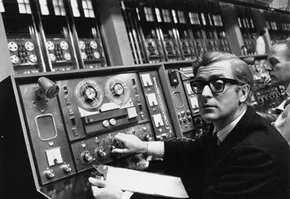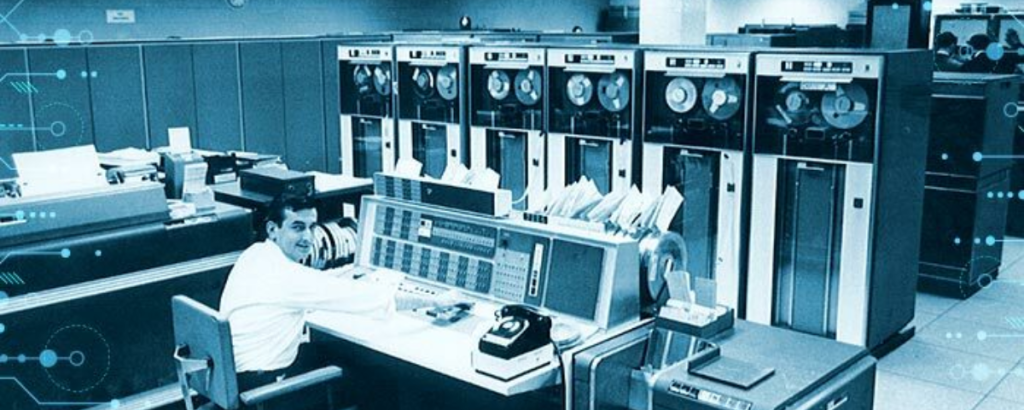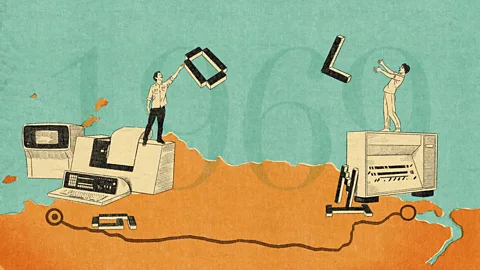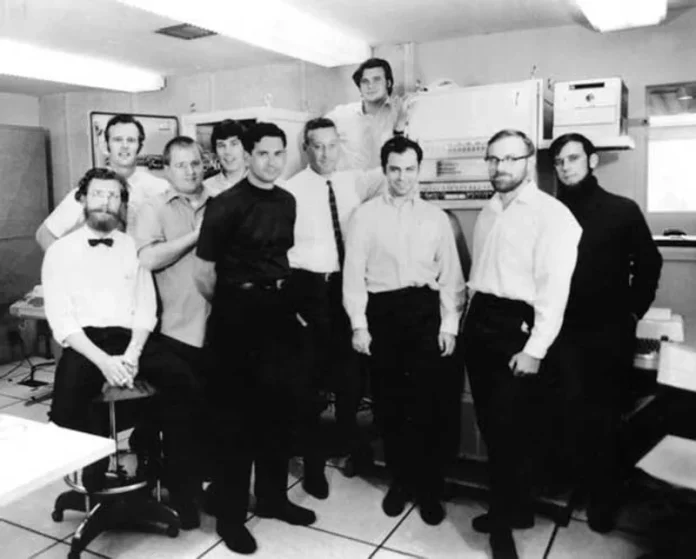The Internet’s Birth: How a Simple Message in 1969 Sparked a Global Revolution
On October 29, 1969, in a small room with lime-green walls at the University of California, Los Angeles, two young computer scientists, Charley Kline and Bill Duvall, sat before massive machines, poised to take part in an experiment that would define the digital age. Kline, a graduate student at UCLA, and Duvall, a systems programmer at Stanford Research Institute (SRI), were about to send the very first message over a revolutionary network known as Arpanet.
Funded by the U.S. Department of Defense, Arpanet was a pioneering project aiming to establish a system through which computers could share data directly without relying on traditional telephone lines. Instead, it used an innovative approach called “packet switching,” a method that would eventually form the backbone of what we now know as the internet.
As the Cold War intensified, technology was advancing rapidly, and both scientists and government agencies were searching for ways to improve communication and collaboration. But back in 1969, neither Kline nor Duvall anticipated the historic significance of what they were about to accomplish. For them, it was simply another problem-solving task, one that required diligence, experimentation, and, as they would soon find out, patience with technical difficulties.
Today, 55 years after their first attempt to send a message, both men reflect on the early days of the internet and how that single attempt to log in marked the start of a global transformation.

The Internet’s Birth: How a Simple Message in 1969 Sparked a Global Revolution
Arpanet, short for Advanced Research Projects Agency Network, was born out of the U.S. Department of Defense’s efforts to improve secure and reliable communication systems during a tense geopolitical period. The goal was ambitious: create a network that could endure significant disruptions, such as natural disasters or nuclear attacks, by breaking data into small packets that could travel independently and be reassembled at the destination. It was an early form of what we now call “packet switching,” a process that allows data to be routed dynamically across networks, laying the foundation for the internet’s fundamental architecture.
The task fell to a handful of bright young engineers at institutions like UCLA and SRI, two of the first nodes in the Arpanet network. Kline and Duvall, both deeply invested in the project, had to connect two mainframe computers located approximately 350 miles apart.
The plan was for Kline, stationed at UCLA’s Boelter Hall, Room 3420, to send a message to Duvall’s computer at SRI. Kline would initiate the connection by typing “LOGIN,” but he didn’t get far. Partway through the word, as he reached “L-O,” the system crashed. This short-lived connection was the first recorded message sent over what would later become the internet, reduced to a simple “L-O” due to a technical failure. It was a small triumph, if incomplete, in the face of countless technical hurdles.
Today, Kline recalls the incident with humor, although at the time, the partial message was frustrating. “I certainly didn’t realize the significance of it at that time,” he admitted in a recent interview with the BBC. “We were just trying to get it to work.” With Duvall on the other end of the line, Kline and his colleague worked to fix the issue, and within an hour, the connection was re-established, allowing them to complete the initial “LOGIN” message. What followed was a landmark achievement in computing, and the engineers celebrated the successful transfer as a technical breakthrough, even if it felt like a small victory in the moment.

Arpanet quickly expanded, linking computers at research institutions across the United States and enabling a new era of digital communication. Over the following years, engineers and scientists would continue to improve the technology, gradually transitioning it from a specialized tool of government and academia to a public resource that would eventually reshape commerce, communication, and culture. However, it wasn’t until the 1980s, when the adoption of Transmission Control Protocol/Internet Protocol (TCP/IP) established a universal standard, that the internet began to resemble the global network we know today.
By the early 1990s, Arpanet had evolved into what would be formally known as the internet. The emergence of the World Wide Web in 1989, developed by British scientist Tim Berners-Lee, transformed the internet from a tool of data transfer into an interactive platform where information could be freely accessed and shared across the world. The first websites were created to distribute scientific papers and data, but it didn’t take long for commercial entities and private citizens to see its potential.
As people began to access the internet through personal computers, then smartphones and other devices, the global network expanded rapidly. Today, almost every aspect of life has been touched by the internet: communication, entertainment, education, work, and even social interactions have been fundamentally reshaped by digital connectivity. The internet has shrunk the world down to a small black box that fits in your pocket, allowing users to access information instantly from nearly anywhere on the planet. More than half of the world’s population now has access to the internet, a testament to the network’s transformative power.
Reflecting on the transformation of the internet, Kline and Duvall share a sense of amazement at how far the technology has come. The frustrations they encountered back in 1969—when their early attempts to connect were thwarted by simple system limitations—are minor compared to the complexities and challenges the internet has since brought. From cybersecurity issues and data privacy concerns to the impact on mental health and society, the internet’s growth has been accompanied by new questions about its place in our lives.
Kline remarked on how surprising it is that something initially designed as a communication tool for government and academics now has such a wide reach. The rise of social media, the proliferation of e-commerce, and the advent of artificial intelligence were nearly unimaginable during the days of Arpanet’s development. The internet’s influence now extends to sectors as diverse as finance, health, and education, with everything from online banking and telemedicine to virtual classrooms made possible by the technology first tested with the typing of “L-O.”

Today’s internet brings both tremendous benefits and significant challenges. The digital divide—the gap between those with and without access to the internet—remains a pressing issue, with billions still unable to connect due to infrastructure, cost, or government restrictions. Meanwhile, the nature of online interaction has changed the way people communicate and even perceive reality. Cybersecurity threats, such as data breaches and online misinformation, highlight the darker sides of the internet’s open and instantaneous nature.
Duvall, reflecting on the current state of technology, expressed a sense of wonder but also caution. “We built something we thought would just improve communication,” he said. “But now it’s transformed every aspect of society, and not all for the better. Still, I think we’ve only scratched the surface of what’s possible, both good and bad.”
The 55th anniversary of the internet’s first message underscores the importance of early experiments in packet switching and digital communication. The initial technical hiccup, which Kline and Duvall encountered in 1969, feels emblematic of the broader journey of the internet—a constant evolution, marked by trial and error. The “L-O” message was only the beginning of a monumental shift in how humans share information.
Looking forward, the internet’s potential continues to expand as new technologies emerge. The recent development of quantum computing, the growth of machine learning and artificial intelligence, and advancements in 5G networks suggest that the internet of the future will look vastly different from today’s iteration. In many ways, we are still discovering the power of the technology Kline and Duvall helped to bring to life 55 years ago.
As the anniversary of that groundbreaking day is celebrated, it serves as a reminder of the internet’s modest beginnings and the engineers who saw beyond the limits of telephone lines and envision a future of global connectivity. What started as a simple “L-O” has grown into a vast network that connects billions, shaping and reshaping the world in ways those early engineers could never have imagined. Kline and Duvall may have only been trying to solve a technical problem, but their persistence sparked a revolution that continues to unfold every day.




